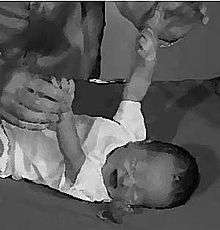Palmar grasp reflex

Palmar grasp reflex (sometimes simply called grasp reflex) is a primitive reflex. It appears as early as 16 weeks[1] in utero[2][3][4] and persists until five or six months of age. When an object is placed in the infant's hand and strokes their palm, the fingers will close and they will grasp it with a palmar grasp. The grip is strong but unpredictable; though it may be able to support the child's weight, they may also release their grip suddenly and without warning. The reverse motion can be induced by stroking the back or side of the hand.[5]
Significance
If Palmar grasp reflex persists beyond 2 to 4 months, it delays or affects functions like grasping a rattle, releasing objects from hand and also hand manipulation skills. Palmar grasp reflex may be a sign of anterior cerebral artery syndrome in an adult patient.
References
- ↑ Sherer, DM (June 1993). "Fetal grasping at 16 weeks' gestation.". Journal of ultrasound in medicine : official journal of the American Institute of Ultrasound in Medicine. 12 (6): 316. PMID 8515527.
- ↑ Jakobovits, AA (2009). "Grasping activity in utero: a significant indicator of fetal behavior (the role of the grasping reflex in fetal ethology).". Journal of perinatal medicine. 37 (5): 571–2. doi:10.1515/JPM.2009.094. PMID 19492927.
- ↑ Jakobovits, A (2 September 2007). "[Grasping reflex activity in utero is one element of fetal behavior (Grasping activity is a part of fetal ethology)].". Orvosi hetilap (in Hungarian). 148 (35): 1673–5. doi:10.1556/OH.2007.28089. PMID 17720675.
- ↑ Kurjak, A; Stanojevic, M; Andonotopo, W; Salihagic-Kadic, A; Carrera, JM; Azumendi, G (2004). "Behavioral pattern continuity from prenatal to postnatal life--a study by four-dimensional (4D) ultrasonography.". Journal of perinatal medicine. 32 (4): 346–53. doi:10.1515/JPM.2004.065. PMID 15346822.
- ↑ Futagi, Yasuyuki; Toribe, Yasuhisa; Suzuki, Yasuhiro (2012). "The Grasp Reflex and Moro Reflex in Infants: Hierarchy of Primitive Reflex Responses". International Journal of Pediatrics. 2012: 1–10. doi:10.1155/2012/191562.